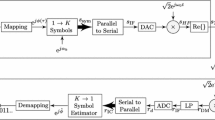Abstract
Ad hoc networks can provide a total tra.c carrying capacity that scales as the square root of the number of nodes in the network. The operation of ad hoc networks requires several asynchronous distributed protocols which can adapt to the location and number of nodes in the network, and to the tra.c demands. We present three such protocols for problems arising especially in wireless networks ‐ power control (COMPOW), media access (SEEDEX), and routing (STARA). We also comment on some architectural issues important to the next phase of the information technology revolution, the convergence of communication, control, sensing and actuation.
Access this chapter
Tax calculation will be finalised at checkout
Purchases are for personal use only
Similar content being viewed by others
Author information
Authors and Affiliations
Editor information
Editors and Affiliations
Rights and permissions
Copyright information
© 2002 Springer-Verlag Berlin Heidelberg
About this paper
Cite this paper
Kumar, P.R. (2002). Ad Hoc Wireless Networks: Analysis, Protocols, Architecture, and Convergence. In: König-Ries, B., Makki, K., Pissinou, N., Makki, S., Scheuermann, P. (eds) Developing an Infrastructure for Mobile and Wireless Systems. IMWS 2001. Lecture Notes in Computer Science, vol 2538. Springer, Berlin, Heidelberg. https://doi.org/10.1007/3-540-36257-6_3
Download citation
DOI: https://doi.org/10.1007/3-540-36257-6_3
Published:
Publisher Name: Springer, Berlin, Heidelberg
Print ISBN: 978-3-540-00289-5
Online ISBN: 978-3-540-36257-9
eBook Packages: Springer Book Archive




